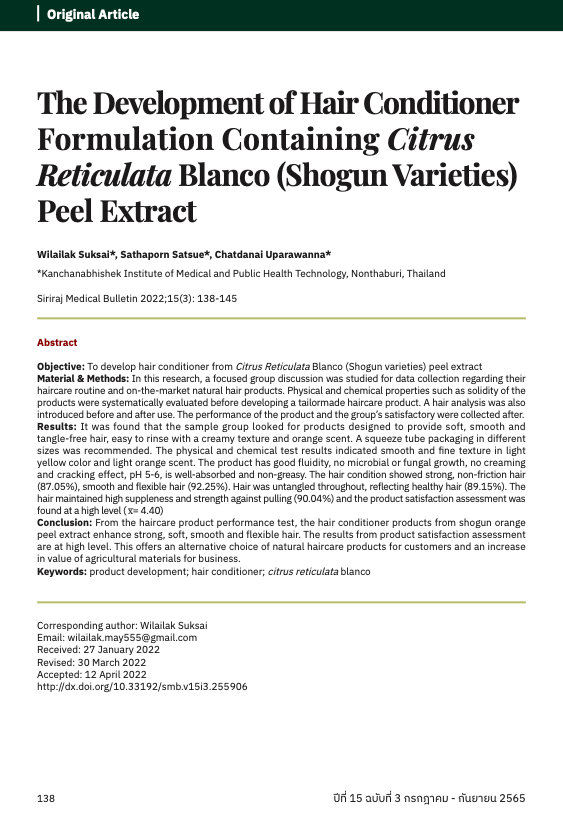The Development of Hair Conditioner Formulation Containing Citrus Reticulata Blanco (Shogun Varieties) Peel Extract
Main Article Content
Abstract
Objective: To develop hair conditioner from Citrus Reticulata Blanco (Shogun varieties) peel extract.
Material & Methods: In this research, a focused group discussion was studied for data collection regarding their haircare routine and on-the-market natural hair products. Physical and chemical properties such as solidity of the products were systematically evaluated before developing a tailormade haircare product. A hair analysis was also introduced before and after use. The performance of the product and the group’s satisfactory were collected after.
Results: It was found that the sample group looked for products designed to provide soft, smooth and tangle-free hair, easy to rinse with a creamy texture and orange scent. A squeeze tube packaging in different sizes was recommended. The physical and chemical test results indicated smooth and fine texture in light yellow color and light orange scent. The product has good fluidity, no microbial or fungal growth, no creaming and cracking effect, pH 5-6, is well-absorbed and non-greasy. The hair condition showed strong, non-friction hair (87.05%), smooth and flexible hair (92.25%). Hair was untangled throughout, reflecting healthy hair (89.15%). The hair maintained high suppleness and strength against pulling (90.04%) and the product satisfaction assessment was found at a high level ( x̅ = 4.40).
Conclusion: From the haircare product performance test, the hair conditioner products from shogun orange peel extract enhance strong, soft, smooth and flexible hair. The results from product satisfaction assessment are at high level. This offers an alternative choice of natural haircare products for customers and an increase in value of agricultural materials for business.
Article Details

This work is licensed under a Creative Commons Attribution-NonCommercial-NoDerivatives 4.0 International License.
References
Blume-Peytavi U, Whiting DA, Trüeb RM. Hair growth and disorders. 1st ed. Berlin: Springer-Verlag Berlin Heidelberg; 2008. 564 p.
Tsuboi R, Itami S, Inui S, Ueki R, Katsuoka K, Kurata S, et al. Guidelines for the management of androgenetic alopecia (2010). J Dermatol. 2012; 39:113–20.
Varothai S, Bergfeld WF. Androgenetic alopecia: an evidence-based treatment update. Am J Clin Dermatol. 2014; 15(3):217–30.
Programming [Internet]. A Study of Hair Growth Promoter in Pigmented Rice Extract and Development of Anti-hair Loss Products Containing Pigmented Rice Extract; c2012 [cited 2018 Dec 1]. Available from:
https://programming.cpe.ku.ac.th/AgriInformatics/viewProject.php?itemID=3295 (in Thai)
Nassar AG, AbdEl-Hamied AA, EL-Naggar EA. Effect of citrus by-products flour incorporation on chemical, rheological and organolepic characteristics of biscuits. World J. Agric. Sci. 2008;4(5): 612-16.
Lario Y, Sendra E, Garc J, Pérez A, Fuentes C, Sayas-Barberá E, et al. Preparation of high dietary fiber powder from lemon juice by-product. Innov Food Sci Emerg Technol. 2004;5(1):113-17.
Ghasemi K, Ghasemi Y, Ebrahimzadeh MA. Antioxidant activity, phenol and flavonoid contents of 13 citrus species peels and tissues. Pak J Pharm Sci. 2009;22(3):277-81.
Pumpuang P, Rattanachot A. A study on collagen content from the waste of citrus reticulata blanco (seetong, mandarina, and shogun varieties) (special problem). Department of thai traditional medicine. Nonthaburi: Kanchanabhishek Institute of Medical and Public Health Technology; 2017. (73). (in Thai)
Boonworaphat W. Thai-chinese herbal encyclopedia, frequently used in thailand. 1st ed. Bangkok: The association of chinese traditional medicine in Thailand; 2011. 655p. (in Thai)
thaicrudedrug.com [Internet]. Mandarin Orange; c2010 [cited 2019 Mar 1]. Available from: http://www.thaicrudedrug.com (in Thai)
siamchemi.com [Internet]. Benefits and toxicity of citric acid; c2020 [cited 2020 Aug 18]. Available from: https://www.siamchemi.com (in Thai)
Nopkesorn T. Qualitative methods vol1. 1st ed. Nakhon Ratchasima: Chokcharoen Marketing Co., Ltd.; 2008. (in Thai)
Tantipaibulvut S, Nuamsetti T, Dechayuenyong P. Antibacterial activity of some fruit-peel extracts. KKU Res. J. 2012; 17(6):880-894. (in Thai)
Chemistry and pharmaceutical technology subject group. Manufacture of herbal cosmetics. Ubon Ratchathani: Ubon Ratchathani University Press; 2005. 26p. (in Thai)
Krasantisuk S, Runnarong H. The development of skin care sericin lotion (special project). Faculty of pharmacy. Nakhon Pathom: Mahidol University; 2006. (60). (in Thai)
Likert R. New patterns of management. New York: McGraw-Hill Book Company Inc; 1961. 279 p.
Pasunon P. Validity of questionnaire for social science research. Journal of Social Sciences Srinakharinwirot University. 2015;18:375–96. (in Thai)
Hoffmann R, Happle R. Current understanding of androgenetic alopecia. part I: etiopathogenesis. Eur J Dermatol. 2000;10(4):319-27.
ratchakitcha.soc.go.th [Internet]. Announcement of the Ministry of Industry No.4462(2012); c2012 [cited 2020 Aug 18]. Available from: http://www.ratchakitcha.soc.go.th (in Thai)
Gorantla N, Prasad KS, Thimma Reddy VT, Ragadeepika J, Hajarabi T, Ahad HA. Formulation and evaluation of herbal shampoo containing chamomile, rose and orange peel. IJMPR. 2013;1(2): 192-97.
Sunsanee P. Determinants of service quality as perceived by consumers in chiang mai (thesis). Chiang Mai: Chiang Mai University; 1997. (in Thai)






